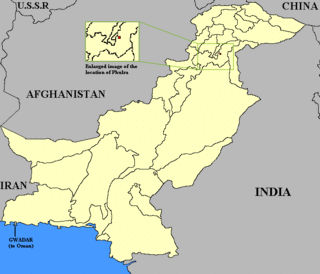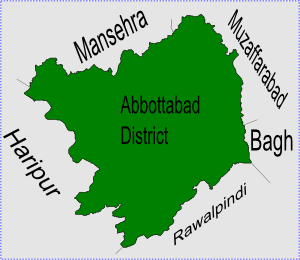
Hindko is a cover term for a diverse group of Lahnda dialects spoken by several million people of various ethnic backgrounds in several areas in northwestern Pakistan, primarily in the provinces of Khyber Pakhtunkhwa and northwestern regions of Punjab.
The Tareen is a Pashtun tribe inhabiting southern Afghanistan, and western region of Pakistan.

The Tanoli are a Hindkowan tribe living mainly in the Hazara area of Khyber Pakhtunkhwa, Pakistan. They form the majority of the population of Lassan Nawab union council. The Tanoli describe themselves as Barlas Turks. They never submitted to the British colonial rule in the 1840s. They have two major divisions, namely Palaal and Hindaal. In present day, the majority of the Tanolis speak the Hindko language.

Amb or the State of Amb was a princely state in the present day Khyber Pakhtunkhwa region of Pakistan. Together with Phulra, it was known as Feudal Tanawal ruled by Tanoli tribe. A Royal Tenure start from Timurid Empire and end on Last Nawab Muhammad Farid Khan Tanoli. Amb was only powerful state incorporated in Pakistan with armed civilized military of 12,000 men, 300 Howitzer with their own manufacturing arms factory, today part of the Pakistan Army. Amb had a influence control roots in Swat, Dir and Chitral. A gaining of powerful roots of Amb military start from Second Anglo-Sikh War when East India Company provide military equipment to Jehandad Khan Tanoli to fight against Sikh, and then next British Empire in Second anglo-Afghan War. At the end of December 1947, the Nawab of Amb state acceded to Pakistan while retaining internal self-government. Amb continued as a princely state of Pakistan until 1969, when it was incorporated into the North West Frontier Province.

Hazara, historically also known as Pakhli, is a region in northern Pakistan, falling administratively within the Hazara Division of the Khyber Pakhtunkhwa province. It forms the northernmost portion of Sindh Sagar Doab, and is mainly populated by the indigenous Hindko-speaking Hindkowans and Kohistani people, with a significant Pashto-speaking population. The inhabitants of Hazara are collectively called the Hazarewal.

Phulra or the State of Phulra was a Muslim princely state in the days of British Raj and ruled by the Tanoli tribe, located in the region of the North West Frontier to the east of the nearby parent princely state of Amb (Tanawal).
Chamhatti is a village located in newly created Tehsil Lower Tanawal and is the part of Union Council Sherwan of Abbottabad District in Khyber Pakhtunkhwa province of Pakistan. It was an independent union council until 2002 but later on it was merged with Union Council Sherwan. Tanoli is the notable tribe of Chamhatti village and surrounding areas along with some other tribes like Awan, Syed and Gujjer etc. Its neighbouring villages are: Juhna, Dera Sharif, Nakka, Khalabat, Kangar Bala, Kangar Pain, Ahmad Abad, Thathi Ahmad Khan, Namshehra, Kharpir, Kameela, Nechaan, Beri, Chakar Bayaan Khurd and Chakar Bayaan Kalan. Chamhatti is located at a distance of about 25 Kilometers from Mansehra City and a distance of about 50 Kilometers from Abbottabad.
Lakhala Village (لکھالہ) is a village of Abbottabad District in Khyber Pakhtunkhwa, Pakistan. It is at 34°11′0″N73°0′0″E in the west of the district. Its Thana is Sherwan,Tehsil Lower Tanawal and district Abbottabad. Lakhala village is property of the Khan. Mr. Khanzada Muhammad Rajwali Khan Tanoli was King of this village. He died on 9th may 1922.
Amirabad is a village of the Union Council of Sherwan in the Abbottabad District of Khyber Pakhtunkhwa, province, Pakistan, it is located 24 km north west of the city of Abbottabad and 5 km east of Sherwan.

Abbottabad Tehsil is an administrative subdivision (tehsil) of Abbottabad District in the Khyber Pakhtunkhwa province of Pakistan.
Attock Khurd is a small town located beside the Indus River in the Attock District of Punjab Province in Pakistan. Khurd and Kalan are Persian words, meaning small and big, respectively. The words are themselves derived from Middle Persian. When two villages have the same name in the same vicinity, they are often distinguished by adding Kalan and Khurd with the villages' names.

Nawab Jehandad Khan Tanoli was a chief of Tanoli tribe in the Hazara region of the North-West Frontier of British India and Nawab of Amb. Jehandad Khan Tanoli was the son of Mir Painda Khan, a fighter against the Sikh Empire. He became the ruler of Amb on the death of his father in 1844.
Painda Khan Tanoli was a powerful chief and warrior in Tanawal area of North-West Frontier region of India. Painda Khan's rebellion against the Sikh empire cost him much of his kingdom, leaving only the tract around Amb, with its twin capitals of Amb and Darband.
Hazarewal or Hazarawals refer to the multi-ethnic community inhabitants of the Hazara region in Northern Pakistan. This region is known for its multi-ethnic population, comprising various ethnic groups with diverse origins.

Khan Abdul Majid Khan Tarin (1877–1939), Khan-Sahib, OBE, was a prominent magistrate, MLA and philanthropist of the North West Frontier Province of former British India.

Khan Jalaluddin Khan, aka Jalal Baba, was a Muslim League stalwart and a Pakistan Movement activist who served as the 8th Interior Minister of Pakistan under the Premiership of Feroz Khan Noon. Jalal Baba was a major figure in British Indian and later Pakistani politics, in particular in the North-West Frontier Province.
Muhammad Habib Khan Tarin, Risaldar-Bahadur, CSI, was a cavalry officer of Tarin descent, who lived in the Hazara region on the Punjab Frontier, in British India.

Zabardust Khan Tanoli also known by his nick-name Suba Khan Tanoli was a chieftain of the Tanoli tribe, and the Nawab of Kashmir and Mashrik-i-Kandahar present day Khyber Paktunkhwa in 18th century Mughal India. He fought at the Third Battle of Panipat and his intelligence, rifles and zamburak artillery skills contributed to the Afghan victory. He played a considerable part with Ahmed Shah Abdali to fighting against the Sikh and Hindu Jats.
Mir Nawab Khan Tanoli was the ruler of The Tanawal valley and the Chief of the Hazara region from circa 1810 until he died in 1818. During his rule, he faced many attacks from the Sikh Empire and Durrani Empire, resulting in a significant loss of territory. He was 26 years old when he was assassinated by Azim Khan on October 13, 1818 in the Stratagem of Peshawar.











